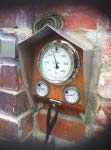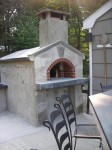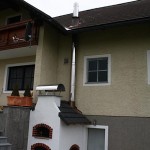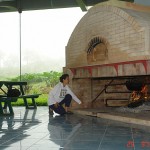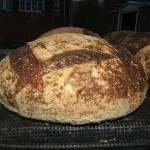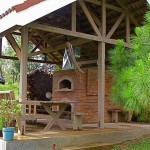back to board Main Page
Re: Reasons to use clay instead of refractory cement?
From the WFO board
Posted by Rado
In Reply to: Re: Reasons to use clay instead of refractory cement? posted by Robert Richard
Hello Robert,
Yes refractory cements cost a lot more then powdered clays, fireclay is even cheaper then other clay bodies in powder form.
Fire bricks are also made out clay, if bought from one manufacturer the fireclay used for mortar is produced exactly from the same clay as firebricks, clay is collected from the same deposit. In the firebrick body you can see lots of sand and even little stones, from fireclay these are sieved out.
26% alumina strong refractory brick:
Material Bulk density 1850kg/m3
Strength - compressive 15MPa
Linear change on reheating (to 1400C for 4 hours!) - permanent 0.3%
K-factor / thermal conductivity at 750C 1.05W/m.K
Rupture 5Mpa
..:: extra reading ::..
Firebricks are the best option for building wood fired oven refractory part, both for the hearth for the floor or complete firing chamber. Fire bricks will last ages, more details about firebricks. There is no much difference in heat conductivity rate depending on alumina content in firebrick body, no need for 30%, higher alumina content is for withstanding higher temperature, standard refractory firebrick with 26% body alumina content have 1350deg.C temperature rating. Such temps can't be reached in a wood burning pizza/bread oven, not even close. Bricks are very good investment, are traditionally used for many generations which is a best test proving quality therefore a peace of mind. Unless one is prepared to go into lots of brick cutting and wedging when making round dome (for it to lasts), to me the best option is making rectangular or square shape floor ovens these are of high quality and last very long, perfectly cook everything from pizza to roasts to delicate baking and with all these qualities making them requires no extensive brick cutting and fiddling to put bricks together right.
For some reasons people often ask questions like if the square dome will heat up a long time or if cooking atmosphere is even in rectangular floor brick dome, of course it is even - production bakers would never want square ovens otherwise, can you imagine how much work they have on amount of dough they must prepare?! ( Many details on that more details. ) Rectangle floor home/family ovens will heat up in similar time as a round home oven, the speed depends mostly on the oven size. If you add to your oven extra dense heat absorbing capacity layer (concrete cladding layer or second brick layer) and compare this oven compare it with oven with exactly same internal size although it's oven which does not have this extra layer, there won't be too much difference in heating up time. But there'll be a big difference in using these 2 ovens, in the oven with thin walls you can not do long time roasting in closed pot for 5 hours or reload when baking breads or when doing both at ones. Thin oven will cool down fast. Rectangular family size brick oven with heavy walls heats up to flat white color inside, hot to start making pizzas, while you make pizzas oven walls continue to absorb heaps of heat from little fire or red hot cinders.
After pizzas wait ~1 hour + for high temperature to drop down and one can start the real cooking/roasting/baking (temperature can be regulated by lifting up closed door making gap at the bottom keeping temperature down.) If you only want to make pizzas you can use oven with thin walls and keep small fire inside while pizzas are going in, then when all pizzas are done and when fire dies the oven cools down too. Brick oven with thin walls will heat up into pizza temperature not much faster then oven with the extra wall thickness, there is other difference I just mentioned above, you cannot use extra firewood because of extra cladding - unless you take into consideration a little difference ;o) Home brick ovens do not consume too much firewood (I made one posting in this forum on firewood usage, with picture showing firewood amount for one firing) it is also very hard to argue about using wood fired ovens is bad for environment. Just compare it with a single bush fire etc. or what goes around in power stations etc., and secondly traditional cooking using wood fire does not involve cutting trees primarily for this purpose.
What about burning of already dry wood collected somewhere in nature? Well, if we leave it there and it'll produce exactly same amount of green house gases through wood rotting process on the ground as it would by burning it. We have here different trouble and that is pollution effecting people with asthma, many find coping with smoke difficult therefore here is another reason why we should build efficient ovens that cook for a long time from a single firing! Tree branch burning will only produce as much of dioxide amount as this branch was capable to absorb while it was growing. It is easy to learn how to fire own oven and not producing smoke except at time when the fire is started.
